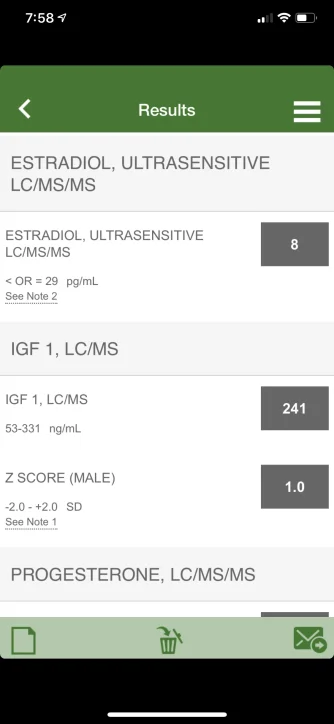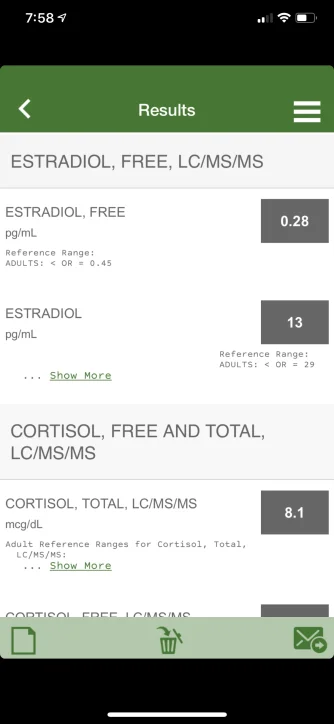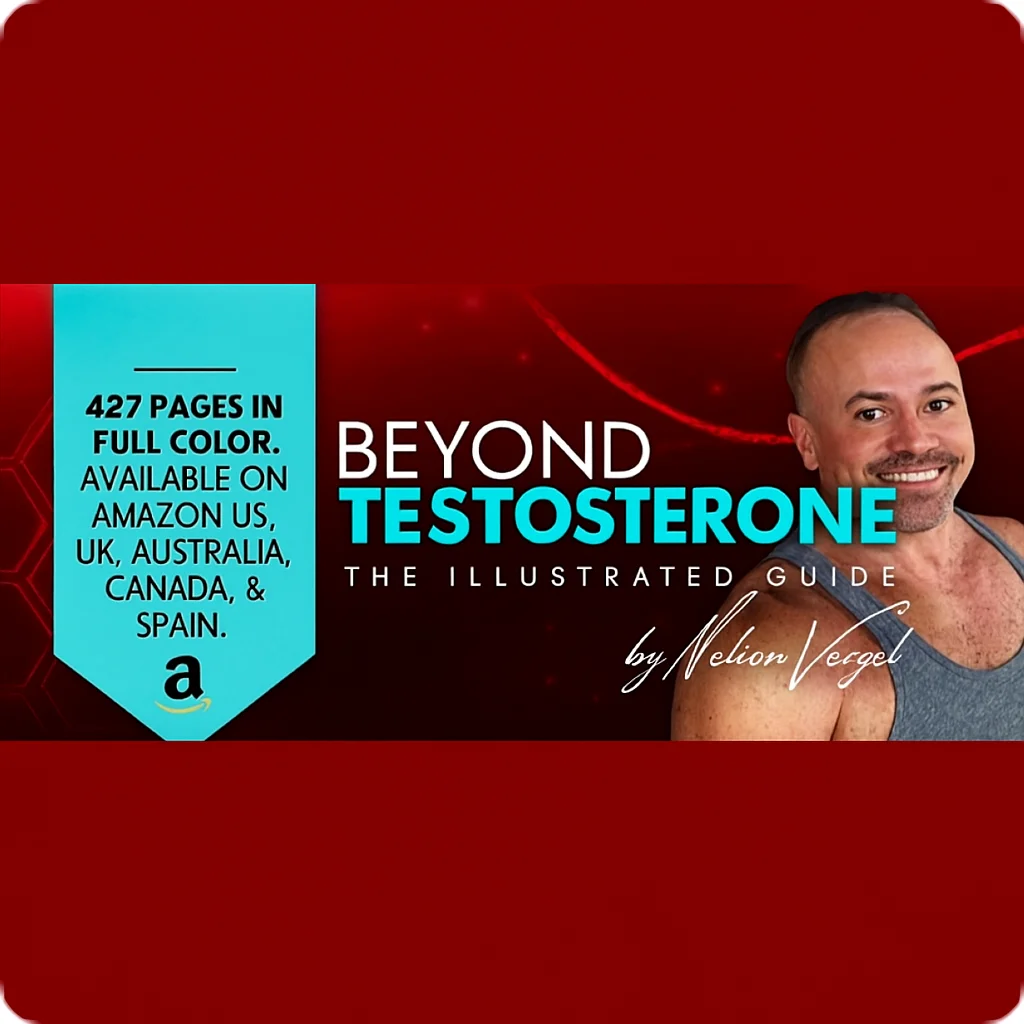There's been a lot discussion recently in
Excelmale on wanting to test for Free E2 and the relatively high cost of this test. There are
online calculators which calculate an estimate of Free T based on Total T, SHBG and Albumin. However there doesn't appear to be an online calculator for estimating Free E2.
I researched the topic and found an
article from 2010 by Norman Mazer, Ph.D, who created an
Excel spreadsheet for calculating Free T, Free E2, Free DHT and others. The first tab in the spreadsheet is titled "user interface" and you input there the values of Total T, Total E2, Albumin and SHBG and the spreadsheet calculates the Free values.
I modified the spreadsheet slightly to make it more user friendly - changed the titles, highlighted the fields to be inputed in Blue and the results in green, and added ability to input data in nmol/L and pmol/L units and to auto convert these units. You can
download the modified spreadsheet .
Enjoy!
ABSTRACT
SHBG is a plasma protein that participates in the regulation of free estradiol and free testosterone in plasma. We discuss the concept of the nature of a free estradiol and how best to ascertain its value. It can be
measured or calculated; the ways in which this can be done are explored along with the
advantages and
disadvantages of each.
1. Introduction
The theme of this special issue is estradiol (E2); the purpose of this communication is to
set out the role of sex hormone-binding globulin (SHBG) in relationship to free estradiol in human plasma. However, we would be remiss if we omitted mention of
SHBG’s multiple other functionalities.
It participates in signal transduction at the plasma membrane where it has a specific binding site [1]; it is a predictor/marker of a number of important disease states [2]; and it is synthesized in a number of tissues, that are unrelated to its presence in plasma, and, in prostate, enhances the action of dihydrotestosterone [3] Thus, although this communication will deal only with SHBG’s function relative to the binding of E2, we should recall that it is
a multi-functional protein whose biology is far from clearly understood.
1.1. SHBG general properties
The first descriptions of SHBG established that it was a
plasma glycoprotein that circulates as a homodimer that binds a variety of sex steroids, most importantly
dihydrotestosterone, testosterone (T) and estradiol. It subsequently became clear that the homodimer binds two molecules of ligand [4], and that the
source of plasma SHBG is the liver [5], which synthesizes and secretes it. Its concentration in plasma is known to be
increased by thyroid hormone, estrogenic hormones, and cirrhosis whereas its concentration is decreased by obesity, androgens, prolactin, puberty, progestins, insulin and IGF-1.
1.2. Free estradiol
E2 is presumed to exist in two physical states in human plasma –
that which is bound to proteins and that which is unbound (free). The
two proteins that bind E2 are SHBG and albumin. We should be aware that the
concept of free estradiol concentration is a theoretical construct and that free or bound hormone is not measured directly in vivo, but rather examined in vitro by a number of techniques which attempt not to disturb the presumed equilibrium which exists in vivo. The theoretical construct arises from the Law of Mass Action which describes the distribution of two or more interacting molecular entities based on their molar concentration and the quantitative strength of the interaction, e.g. the association constant (Ka). The original work on Mass Action was done on chemical kinetics in simplified systems with reactants in a relatively dilute, pH-buffered, aqueous solution. In more complex environments, where bound particles may be prevented from dissociation by their environment, the model of Mass Action may not always describe the behavior of the reaction kinetics accurately. This caveat may bear on some of the inconsistencies between measured and calculated free estradiol discussed below. Fig. 1 sets out, in a formal manner, how one predicts the concentration of free estradiol if the concentration of SHBG, albumin, total estradiol and the appropriate Ka’s are known. Note that this is a cubic equation which may not be familiar, as the two most common expositions of the Law of Mass Action, as applied to this circumstance, result in quadratic equations after a simplifying assumption [7,8]. The simplifications are justified and if all the same numbers are entered into the equations, they all yield the same result. Several intuitive and useful messages are inherent in these equations:
-Increases in SHBG or Ka decrease free E2.
-Increments in an existing excess of total E2 over SHBG all go to free E2.
-When total E2 is small compared to SHBG, the fraction bound depends only on the Ka and SHBG concentration.
- When SHBG and E2 are more or less equal the fraction of E2 bound depends on [total E2], [SHBG], Ka and on [total E2]/ [SHBG].
2. Free E2: calculate or measure?
2.1. Calculate
Substantially more effort has gone into examining the vagaries of free T than free E2. Although there are distinct differences in estimating free T and free E2, the general approaches are the same and, as appropriate, we will cite papers dealing with the approach to calculating/measuring free T.
To calculate free estradiol one must first have an accurate measure of total estradiol, SHBG, albumin, and the appropriate Ka’s. The difficulties with, and problems of, assaying estradiol constitute a large part of this special issue and I would simply emphasize that
without a proper assay for total estradiol, there can be no accurate determination of free estradiol. SHBG can be measured, either by its ligand binding capacity, by immunoassay or, more recently by mass spectrometry [9]. Commercial methods are available for its immunoassay. At least some of those assays have been standardized against the binding capacity of a standard SHBG preparation obtained from the WHO. There are however problems with the standard; its binding capacity is lower than the previous standards, and its Ka for the SHBG steroid interaction is also lower [10]. Further, one need be sure that the standard’s binding activity is equal to its immunologic activity as the two activities must be proven to be identical and are differentially sensitive to denaturation.
Estimation of the proper association constants for E2-SHBG and E2-albumin are problematic (Table 1). As can be seen, there is a >3-fold difference in the highest vs. the lowest Ka for estradiol-SHBG and an almost 2-fold difference in the highest vs. the lowest Ka for estradiol–albumin. Thus,
depending on the choice of Ka, widely discrepant values would be calculated. Finally,
it is possible for a variety of other steroids to compete for binding with E2. This would raise the concentration of free estradiol, but is not ordinarily taken into account in calculated values. For the most part, this does not appear to be a problem in non-pregnant women (in whom competing steroids do not circulate in sufficiently high concentrations to increase free estradiol)
but can yield incorrect results in the presence of unsuspected competitors or in known situations, such as male plasma, where the concentration of T far exceeds that of estradiol and displaces it from SHBG binding sites. If competitors are present and measured, the overall binding equations can be altered and appropriate corrections can be made [11].
Despite all these caveats, calculation is the prevalent way that free E2 is estimated. For those agreeing on the various measurements, and using the same Ka’s, the results can be comparable,
thus giving the false impression of ‘‘accuracy by the majority.’’ Finally, it has been suggested that the binding of ligands to SHBG is allosteric and that the two binding sites on the homodimer do not have the same Ka. Occupancy of one of the sites on the homodimer is posited to alter the Ka of the other. Modeling based on this concept is said to result in calculated values in better agreement with careful measurements of free estradiol than previous models [12].
2.2. Measure
As stated above, free E2 in plasma is a theoretical construct that follows from the Law of Mass Action which was formulated by chemists in the late 1800’s and ‘‘explains and predicts behaviours [sic] of solutes in dynamic equilibrium.’’
Acceptance of the Law of Mass Action does not necessarily imply that all the components of an equilibrium mixture can be accurately measured or, indeed, how it is to be done.
Whatever method is used ideally should not: disturb the equilibrium that exists in vivo; change the environment that exists in vivo (ionic strength pH, etc); and be accomplished at the same temperature that exists in vivo. The two methods that best approximate these criteria are
equilibrium dialysis and
centrifugal ultrafiltration (see Table 2).
2.2.3. Choose a method
The choice is guided by both convenience/ease and the desire to obtain the answer most likely to coincide with the true value of free E2.
Whichever method one chooses, E2 must be accurately and reproducibly measured; this is required whether one calculates or measures. Once having conceded the ability to measure E2, then the calculation offers the advantages of simplicity and economy. SHBG and albumin are easily measured and the calculation is automated.
On the negative side: there is disagreement about the proper Ka’s and SHBG is not properly standardized/harmonized. In spite of these potential hazards, a number of communications have claimed excellent agreement between calculated and measured values for free testosterone [13,16,20] and free estradiol [13]; however, a number of publications find disagreement between measured and calculated values [21–23].
In addition the calculation of free E2 has been compared to measured values, and found to be satisfactory, in only a small sample of postmenopausal patients [13];
the authors caution against using the calculated value in other populations. Moreover, it should be recalled that
E2 is bound to SHBG 2–3-fold less tightly to SHBG than is testosterone, rendering the assumption of a fixed value for albumin unacceptable until the appropriate calculations and experiments are at hand.
This is still an unsettled issue and no irreversible recommendations as to the best way to proceed can be issued at this time. 













